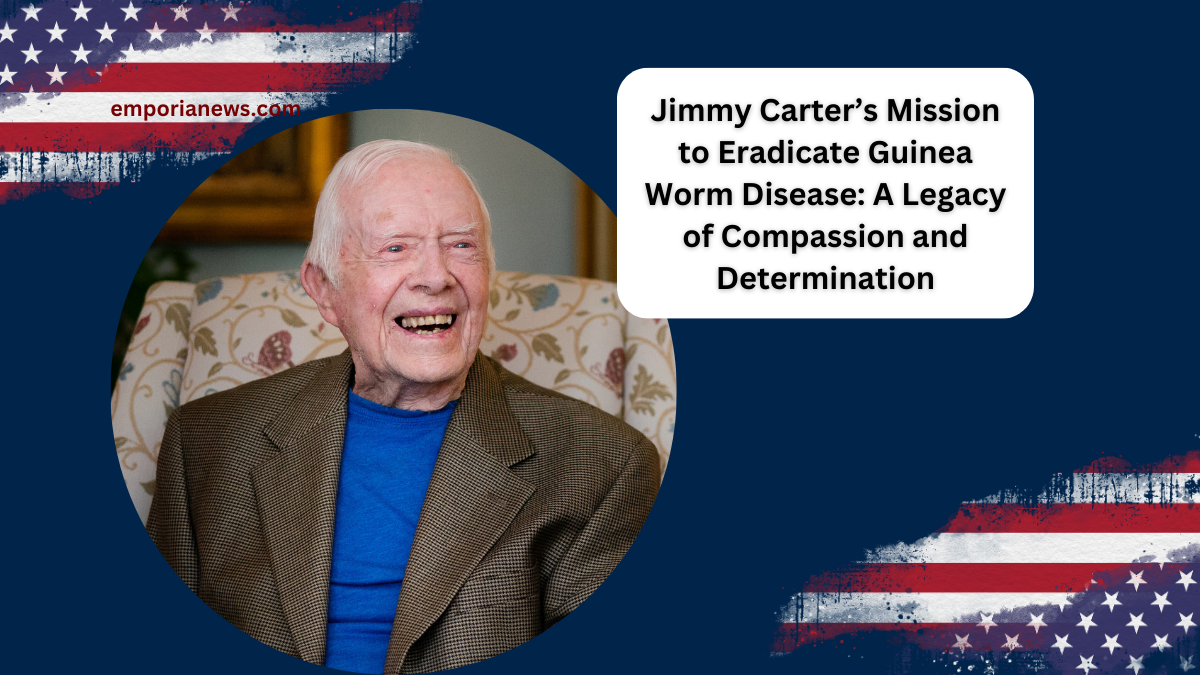Nobel Peace Prize laureate Jimmy Carter dedicated nearly four decades to combating Guinea worm disease, a debilitating condition that primarily afflicted the world’s poorest populations. While rarely fatal, this painful disease is caused by drinking contaminated water containing larvae, which grow into worms up to three feet long. These parasites eventually emerge through the skin, causing severe pain and blisters.
Through The Carter Center—a nonprofit founded by Jimmy and Rosalynn Carter after his presidency—he rallied experts, donors, and volunteers to tackle this ancient scourge. The goal: eradicate Guinea worm disease, making it only the second human disease in history to be eliminated, after smallpox.
The Rise of Guinea Worm Eradication Efforts
In 1986, an estimated 3.5 million people in 20 African and Asian nations suffered from Guinea worm disease. By 2023, only 14 human cases remained across four countries, thanks to The Carter Center’s relentless efforts.
Despite entering hospice care in early 2023, Carter continued to track progress on the eradication of the disease. He passed away at the age of 100, leaving behind a near-eradication of a condition that once devastated millions.
Guinea Worm Eradication Progress
| Year | Cases Reported | Countries Affected |
|---|---|---|
| 1986 | 3.5 million | 20 |
| 2003 | 32,000 | 11 |
| 2023 | 14 | 4 |
How Guinea Worm Disease Impacts Lives
The disease disproportionately affects impoverished communities with limited access to clean water. Infection occurs when individuals drink water contaminated with fleas carrying Guinea worm larvae. The larvae mature inside the body, eventually emerging as worms through painful blisters. Victims often describe the agony as more intense than childbirth.
In places like South Sudan, outbreaks continue to pose challenges. For instance, in the village of Jarweng, four infections were reported in 2022 after a long period of disease-free years. Volunteers and staff distributed water filters and educated villagers to break the parasite’s life cycle.
Carter’s Vision: An Audacious Plan for Global Health
When Carter embarked on this mission, Guinea worm disease was largely ignored by global health agencies and heads of state. Inspired by the success of smallpox eradication, Carter envisioned a similar triumph for Guinea worm.
He leveraged his political acumen to galvanize international support. As Dr. William Foege, a leading public health expert and an early collaborator, noted: “President Carter, with his political background, achieved far more in global health than we could alone.”
Tackling the Disease Without a Vaccine
Unlike many diseases, Guinea worm has no vaccine or pharmaceutical cure. Treatment involves slowly extracting worms through a laborious and painful process that has changed little since ancient times. Instead of relying on medical breakthroughs, Carter’s team focused on behavioral change and prevention.
Key Prevention Strategies:
- Filtering Water: Distribution of nylon cloths and special straws to filter contaminated water.
- Community Education: Training local volunteers to spread awareness about the disease.
- Reporting and Rewards: Encouraging villagers to report cases, often with monetary rewards.
- Preventing Contamination: Ensuring infected individuals and animals do not contaminate water sources.
Expanding Public Health Efforts
Carter’s success with Guinea worm eradication inspired broader initiatives to combat other neglected tropical diseases.
The Carter Center has helped 22 countries eliminate at least one disease, including trachoma, a blinding eye infection. Efforts to eliminate malaria and lymphatic filariasis are also underway in Haiti and the Dominican Republic, with ambitious goals set for 2030.
The Power of Personal Involvement
Jimmy Carter’s direct engagement with afflicted communities amplified the campaign’s impact. By visiting villages, interacting with patients, and using his influence to secure funding and resources, he brought unprecedented attention to Guinea worm disease.
His personal connection to rural poverty, having grown up in a Georgia farmhouse without electricity or running water, deepened his commitment.
In 1988, Carter witnessed the devastating effects of the disease firsthand in Ghana. He recounted meeting a young woman holding what appeared to be a baby, only to realize she was cradling her infected breast as a worm emerged. Such encounters fueled his determination to eradicate the disease.
Overcoming Challenges: From Civil Wars to Natural Disasters
In 1995, civil war in southern Sudan threatened eradication efforts. Carter negotiated a ceasefire, allowing workers to distribute 200,000 water filters and reach isolated villages. This intervention not only reduced infections but also fostered goodwill and trust among warring communities.
Despite setbacks, including resurgence in some regions, significant milestones were achieved. For example, Nigeria, once the epicenter of the disease, reported zero infections by 2009—a transformative achievement that inspired further progress across Africa.
The Final Stretch: Challenges and Hope
Although cases are now rare, the campaign faces hurdles in remote and conflict-ridden areas. Chad, which reported nine of the 13 cases in 2023, struggles with infections in dogs, complicating eradication efforts. Nonetheless, The Carter Center remains steadfast in its mission.
Adam Weiss, who has directed the campaign since 2018, emphasized: “These are the most challenging places on Earth to operate, but the Carter Center is committed to seeing this through.”
Conclusion
Jimmy Carter’s unwavering commitment to eradicating Guinea worm disease is a testament to the power of compassion and determination.
His legacy continues to inspire global health efforts, bringing hope to millions in the world’s most vulnerable communities. As the campaign edges closer to total eradication, it serves as a model for tackling other neglected tropical diseases and improving public health worldwide.
FAQs
1. What is Guinea worm disease?
Guinea worm disease is a parasitic infection caused by drinking water contaminated with fleas carrying Guinea worm larvae. The worms grow inside the body and emerge through painful blisters.
2. How is Guinea worm disease treated?
The treatment involves manually extracting the worm by winding it around a stick. This process can take weeks and is extremely painful.
3. How has The Carter Center contributed to Guinea worm eradication?
The Carter Center has led efforts to eradicate the disease by distributing water filters, educating communities, and encouraging case reporting. Since 1986, the number of cases has dropped from 3.5 million to just 14 in 2023.
4. Why is Guinea worm disease hard to eradicate?
Challenges include conflict zones, displaced populations, and infections in animals like dogs, which complicate prevention efforts.
5. What is the goal for eradication?
The World Health Organization aims to declare Guinea worm disease eradicated by 2030, although The Carter Center hopes to achieve this milestone sooner.




